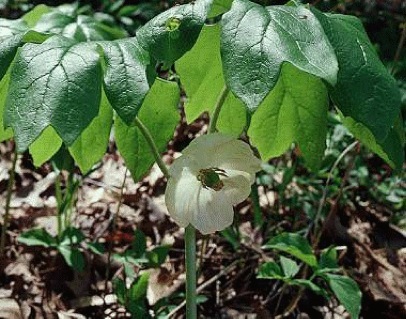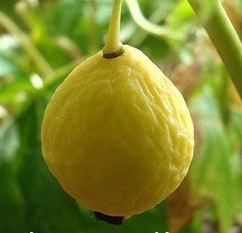Podophyllum peltatum: Forgotten Fruit
The first time I saw a mayapple I was certain something that strange had to be toxic, and it is, unless totally ripe. In fact, all parts of the plant except the very ripe fruit are quite poisonous. Another plant which is like that is the Natal Plum.
When unripe the Mayapple resembles a lime. Then it turns a soft yellow and wrinkles a little, see to the right. That is ripe. The rest of the plant is also often dying at that time as well. Trim off the ends, do not eat the seeds. If you cook with it remove the seeds first. Recipes below.
Other parts of the Mayapple have had a wide range of medicinal uses with native Americans. It is, however, a powerful plant and not to be used lightly: The Indians also used it to commit suicide. Two drugs are made from the Mayapple, etoposide and teniposide. Etoposide is for testicular and small-cell lung cancer, teniposide is used in conditions like brain tumors and infancy leukemia. For those of us old enough to remember “Carter’s Little Liver Pills” Mayapple was a main ingredient that made the pills a laxative and had nothing to do with the liver at all.
Its botanical name is Podophyllum peltatum (poe-doe-FILL-um pell-TAY-tum) and means “foot leaf like a shield.” The leaves resemble a duck’s food — it was once called that — and they tend to hide the flower and fruit, shielding it. The Mayapple usually grows in colonies in leaf-losing forests, meaning it likes to grow in the shade. The taste is exotic, or peculiar, opinions vary
Other local names include: Raccoon Berry, Wild lemon, Ground Lemon, Hog Apple, Indian Apple, Wild Jalap, Duck’s Foot, Umbrella Leaf, and Wild Mandrake though it is not related to the Old World Mandrake, Mandragora officinarum. The Himalayan MayApple, Podophyllum hexandrum aka Podophyllum emodi, reportedly has edible leaves as well.
Green Deane’s “Itemized Profile
IDENTIFICATION: A perennial plant is 1–1½’ tall, some unbranched with a single leaf on a long stalk, others produce two leaves. Stalks light green, round, hairless. leaves, umbrella like, to one food long and across; palmately lobed, 5-9 lobes per leaf, deeply divided, hairless. Blossom a single, waxy, creme-colored flower with six to nine petal, below the leaves. Fruit egg-shaped, green when unripe turning yellow when ripe.
TIME OF YEAR: Blossoms in spring, fruit available in late summer depending on climate, July through September. Usually collected in northern areas when the trees are losing their leaves.
ENVIRONMENT: Moist forests, meadows, flood plains, forest openings, from Quebec to Florida, west to Texas and Minnesota.
METHOD OF PREPARATION: Trail side nibble, the basis for a cold drink, jelly (add pectin) compotes, marmalade, pies and a sauce like applesauce. Mayapples can be canned and they freeze well. Do not eat the seeds. Remove them before cooking. Use them to grow more Mayapples. Over-eating can be mildly laxative. WARNING: DO NOT CONSUME WHEN PREGNANT.
Mayapple Jelly
1 3/4 cups Mayapple juice; strained
3 1/2 cups sugar
1/8 cup lemon juice
3 oz liquid fruit pectin or one dry packet
Wash ripe mayapples, cut away the stem and blossom ends, and any waste parts. REMOVE SEEDS. Cut the fruit into pieces and place in a large kettle with water to cover. Bring to a boil, then simmer until mayapples are tender, mashing during cooking. Strain the juice through a cheesecloth or let it drip through a jelly bag. To the strained mayapple juice, add lemon juice and sugar. Bring the mixture to a boil, stirring constantly, then stir in pectin. Again bring to a boil, stirring constantly, and boil hard until the jelly stage is reached. Remove jelly from heat, skim, and pour into hot, sterilized jelly glasses. Seal at once with hot paraffin or lid in hot bath. Double the recipe if you have plenty of mayapple juice. The amount used in this recipe is the yield of about 2 cups of sliced mayapples simmered in 3 cups of water. Yield: Four small glasses of pale amber jelly
Mayapple Jam
5.5 cups ripe Mayapple fruit 7 cups sugar
1/2 cup water 1 package pectin
1/2 cup lemon juice dash of salt
Combine mayapples, water, and lemon juice. Bring to boil, cover over low heat, simmer for 20 minutes. Stir often. Add sugar and bring back to a boil. Boil hard for three minutes. Add pectin and salt and boil for one minute. Stir and skim off foam. Ladle into sterilized jars, seal with lid or paraffin.
Mayapple Punch
3 cups rip Mayapples fruit 1 cup sugar
3 pieces of ginger root 1 quart ginger ale
Cut up Mayapples, REMOVE SEEDS. Put Mayapple pieces and ginger root in a saucepan, cover with water, and slowly bring to a boil. Simmer 25 minutes. Add sugar. Set aside to cool but stir occasionally. Pour through sieve and press pulp through mesh. Spoon into cups and fill cups with ginger ale. Stir and serve. Depending upon your tastes. Some think it tastes like an earthy banana or pawpaws. It makes excellent preserves and drink. Since woodland creatures like the fruit as well it can be collected just before it is ripe and stored in sawdust until ripe.




